Il ricamo Cutwork è una tecnica comunemente usata sui tessuti per dare un tocco decorativo. It’;S Simile all'applicé, Ma invece di aggiungere tessuto, Lo hai tagliato. Fare questo foglie aperte gli spazi finiti con il punto raso.
It’;è facile guardare il ricamo a taglio e pensare che i progetti intricati richiedano settimane (o mesi) completare, ma con un macchina da ricamo, Puoi creare bellissimi ricami tagliati in un solo pomeriggio. Tutto quello che devi fare è un cerchio, ordinare, sew and rinse — it’;è così facile!
It’;è facile guardare il taglio e pensare che i progetti intricati richiedano settimane (o mesi) completare, ma con un macchina da ricamo, Puoi creare bellissimi tagli in un solo pomeriggio. Tutto quello che devi fare è un cerchio, ordinare, sew and rinse — it’;è così facile!

Servizi di digitalizzazione del ricamo
Ricamo a taglio
Il ricamo Cutwork comporta ricami indipendenti che viene cucito sul tessuto. A seconda del design e dell'aspetto del progetto che desideri, il ricamo disegno può essere circondato da tessuto, oppure può essere metà e metà indipendente sul tessuto.
Disegni per ricamo a intaglio
I disegni da ricamo a intaglio sono progettati appositamente per l'intaglio. Questi disegni includere misure specifiche per favorire l’attuazione. Prima, aggiungeranno una linea di taglio. Questo ti darà uno schema di dove taglierai il tuo ricamo indipendente per guardare. Taglierai all'interno delle linee cucite. Se lo stabilizzatore è attaccato al tessuto, don’;Non tagliare lo stabilizzatore, solo il tuo tessuto. Prossimo, verrà cucito un altro file di ricamo. Si adatterà perfettamente al punto in cui tagli il tessuto. Questo sarà il disegno da ricamo che hai scelto e dovrebbe essere simile al disegno del punto e dell'intaglio.
Stabilizzatore per ricamo a intaglio
You don’;t always realize how important a stabilizzatore is until you’;re doing cutwork! It’;s also important to make sure you’;re using the right stabilizzatore. If you use a cutaway stabilizer for any cutwork embroidery project, you’;ll spend a lot of time trying to get your scissors out of the design. As the point of the cutwork embroidery is freestanding embroidery, you want nothing to be left behind or shown in your embroidery. This technique requires the use of a wash-away stabilizer. Getting rid of your stabilizzatore shading is as easy as washing your design in hot water.
Nota: I would recommend doing a test with your wash-away stabilizer first as all household water is different. If hot water isn’;t removing the stabilizer, try adding a little fabric softener or hair conditioner.
Fabrics for Cutwork Embroidery
Il tessuto che usi nei progetti di ricamo a taglio può influire sui risultati. Se usi il tessuto con troppo o troppo poca densità, Può causare troppi movimenti o causare il tuo disegno cucire male. I recommend using a cotton material but make sure your item is washed first to ensure it doesn’;T restringi dopo averlo cucito.
Discussioni per ricamo a taglio
Sebbene i molti diversi tipi di filo rendere difficile determinare cosa è meglio usare per tagliare, Consiglio di usare il thread di rayon. Rayon è lusinghiero, ha una lucentezza alta, e offre molte scelte di colore diverse. Può funzionare bene nel cucito ad alta velocità e ha una sensazione morbida, Perfetto per ricami intricati. Non consiglierei di usare il poli. Anche se ha un punto di rottura elevato, La natura sintetica del poli la rende leggermente spugnosa nell'aspetto e nell'aspetto quando lo stabilizzatore si dissolve.
Forbici per ricamo a taglio
Puoi usare qualsiasi forbice da ricamo, Ma quando si tratta di ricamo a taglio, Consiglio di utilizzare forbici curve a doppio taglio da 6 pollici. Ciò è dovuto a come sono progettati. La maniglia è curva, permettendoti di raggiungere dentro e sotto il tessuto come una pala. La lama delle forbici punta verso l'alto. This is because the blade doesn’;t cut through anything you don’;voglio tagliare, come lo stabilizzatore o la parte inferiore del tessuto. Questa finitura aiuta anche con precisione e dettagli intricati, Il che è essenziale quando si creano taglieri nel ricamo.
How To Do Cutwork Embroidery –; Esercitazione
Voglio mostrarti un progetto di Pasqua davvero carino Cutwork. This is a cutwork egg with an Easter bunny inside. You can read below what I’;m going to do with them.
This pattern comes from advanced disegni da ricamo. The largest hoop size on my machine is 5 X 7 and this pattern is 5 X 8. I was shocked, but it works. I don’;t understand why I thought this pattern was too big for my machine, but it still fits inside my hoop. I can’;t promise your own machine though. I originally picked up this pattern for free last year. They have monthly free designs. If it wasn’;t free I would be afraid to buy it thinking it wouldn’;t work for my machine.
Fare un passo 1:
Choose your clothes. È meglio usare una piccola stampa. Ho usato un tono rosa brillante per il primo tono e il filo bianco. Per il secondo ho usato un tessuto tono-su tono bianco con un filo di colore diverso. Mantieni una ferita a bobina piena e un ago di ricamo fresco fresco per questo progetto.
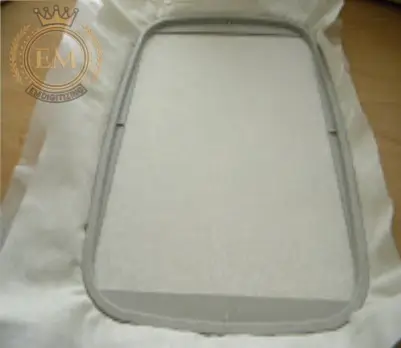
Fare un passo 2:
Tessuto a cerchio con acqua solubile stabilizzatore sul lato in basso a destra. Entrambi sono in un ciclo. Oscillare forte.
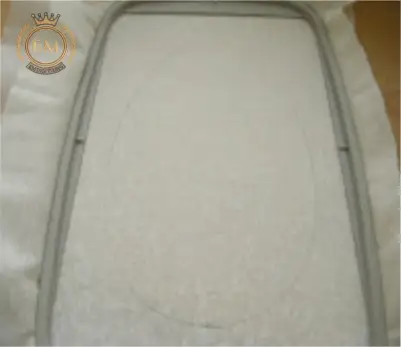
Fare un passo 3:
Il primo punto è un punto dritto all'esterno dell'uovo. Rimuovere il cerchio dalla macchina e tagliare una piccola sezione di tessuto dall'esterno di questo punto. Ho tagliato circa mezzo pollice di distanza che puoi vedere di seguito. Guarda attentamente. Le cuciture sono dentro dove ho tagliato. Ho tagliato un mezzo pollice fuori dalla cucitura. Ricorda queste due cose: 1. Basta rimuovere il cerchio dalla macchina. Non rimuovere i vestiti dal cerchio! 2. Don’;T tagliare il tuo stabilizzatore idrofonante. Basta tagliare il tessuto! (I’;Non sto cercando di essere banale qui 😉 Voglio davvero enfatizzare queste due cose.)
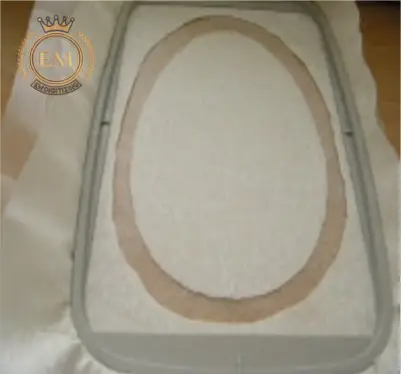
Taglia molto vicino alla linea di cucitura per i migliori risultati. Nel primo campione che ho fatto, quello rosa, Avevo paura di tagliare troppo ed era difficile ripulire i bordi sfilacciati. Sul secondo campione, I cut about 1/32″; to 1/64″; di un pollice, Molto vicino alla cucitura!
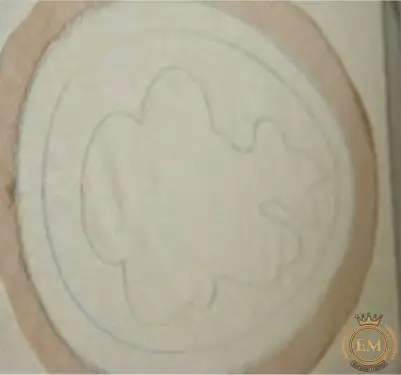
Fare un passo 4:
Il secondo punto è il contorno dell'interno dell'uovo e il contorno del design degli interni.
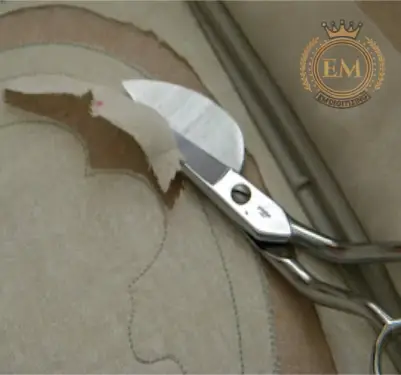
Fare un passo 5:
Ancora una volta rimuovi il cerchio dalla macchina e taglia solo il tessuto tra il coniglio e l'uovo interno. Mantenere lo stabilizzatore. Le forbici Applique sono uno strumento molto utile per il taglio vicino alla linea di cucito.
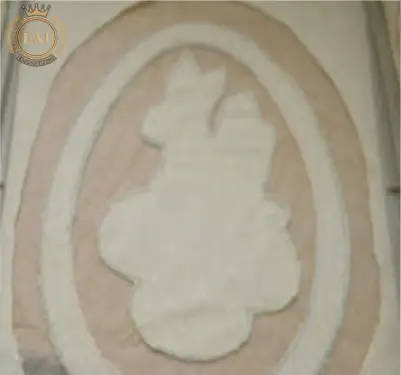
Fare un passo 6:
Il terzo punto è il lavoro e il design di tutto il pizzo. That’;S parte richiede più tempo. Siediti e controlla alcuni blog e leggi un po 'mentre la macchina fa la sua magia.
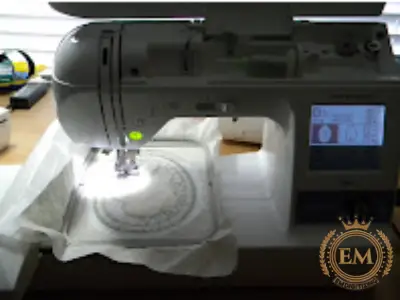
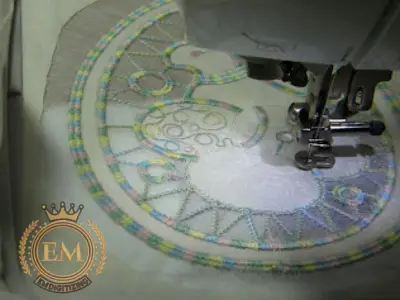
Fare un passo 7:
Il quarto e ultimo punto è un punto decorativo tra il rivestimento uovo interno ed esterno. Puoi cambiare il colore del filo in base a te.
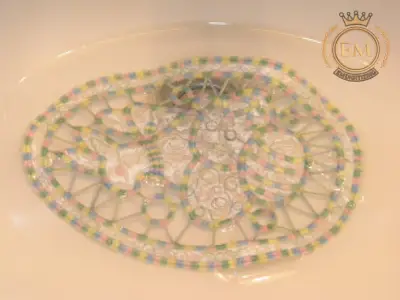
Fare un passo 8:
Rimuovere il cerchio e separare il tessuto dal cerchio. Taglia lo stabilizzatore vicino all'esterno dell'uovo e immergi l'intero progetto in acqua. Questo dissolverà lo stabilizzatore idrofonante. Premere, asciugare e divertirsi!!!
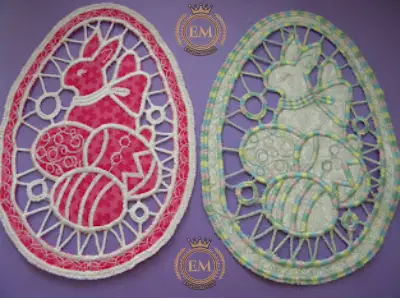
Conclusione
Auspicabilmente, Questo tutorial ti ha aiutato a capire un po 'di più sul ricamo a taglio. Mentre il risultato finale può sembrare intimidatorio, Il processo è più facile di quanto si possa pensare. If you haven’;t already, try sewing your own cutwork disegno del ricamo! Let me know if this tutorial helped or if you have any questions below!
Cutwork or cut work, also known as punto tagliato in Italian, is a needlework technique in which parts of textile, di solito cotone o lino, sono tagliati, resulting in “;holes”;.
Cutwork è una tecnica di ricamo di superficie e utilizza due punti principali: Punto di corsa e bottone a buca. È lavorato su lino fine o panno di cotone o prato. Di solito è lavorato in fili che corrispondono al colore del tessuto, tradizionalmente bianco o ecru.
Cutwork è generalmente considerato parte del ricamo bianco. Viene utilizzato per decorare gli articoli per la casa (biancheria da tavola, asciugamani a mano, tende, Lince da letto), Linence della chiesa, e persino vestiti.
Cutwork è una tecnica di ricamo in cui vengono ritagliate piccole sezioni di tessuto e i bordi grezzi sono completamente coperti di punti. Cutwork is often done on linen with designs on the edge or as part of the embroidery on the linen.
Fine zigzag stitching
Use a fine zigzag stitch to join all the edge pieces together. Connect the bobbin thread to the embroidery thread so that the front and back of the lacework match.
